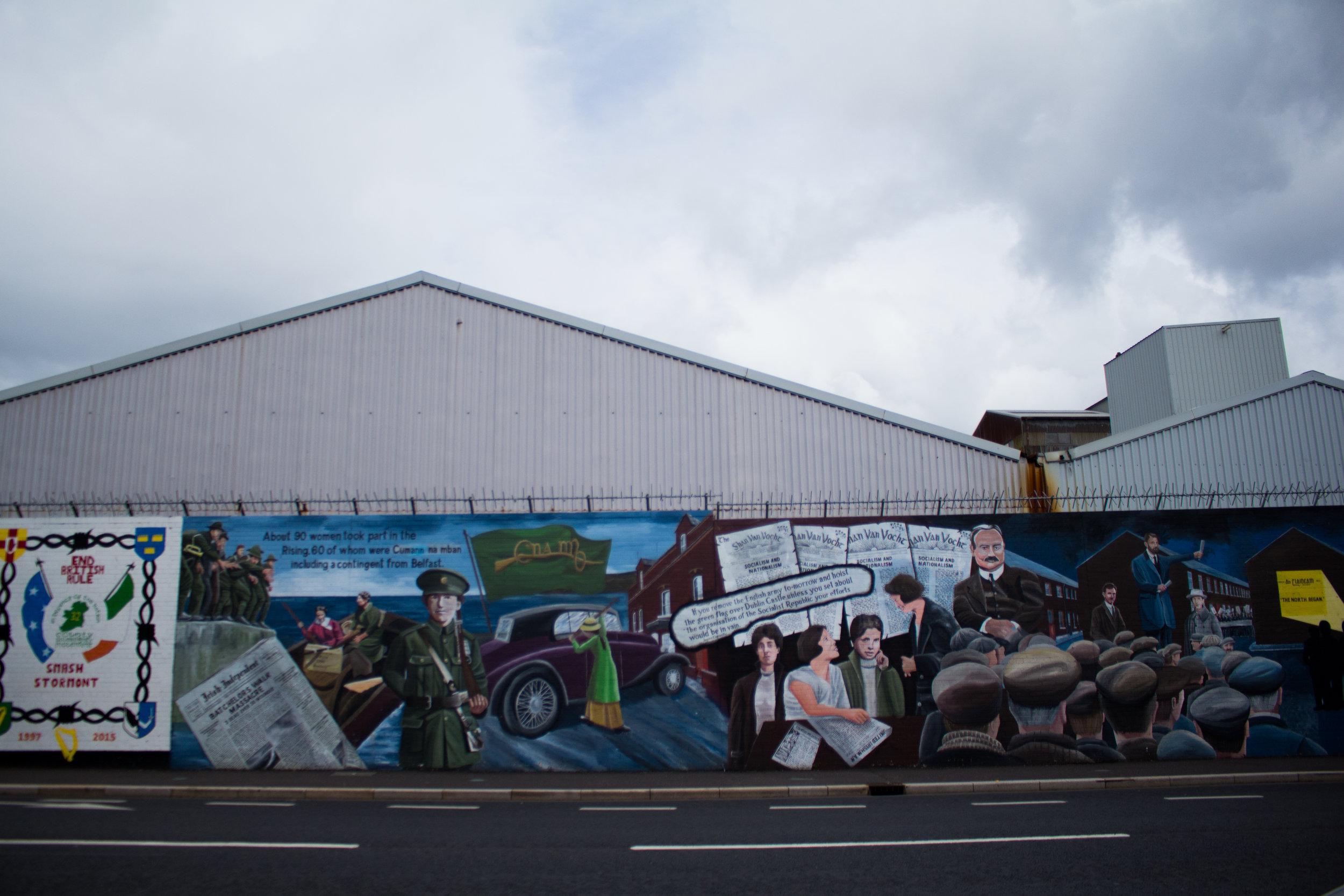belfast: bricks in the wall.

The "Peace Walls" (pictured) run along Falls Road, and through the rest of Belfast.
Belfast is not just the birthplace of the RMS Titanic. Teeming with tourists from around the world, the city is rich in history, culture, and politics. As the capital of Northern Ireland, Belfast has been at the center of much sociopolitical controversy. In 1969, when riots broke out during The Troubles, barricades were placed around the city to segregate Catholic and Protestant communities in order to prevent overwhelming violence against one and other.
On a rainy afternoon this June, I found myself at the foot of Divis Tower on Falls Road, in Belfast. Talking emphatically to a small group of people, a man named Robert made himself known as our guide for the walking tour. The few of us who had managed to brave the Irish weather had come to learn about the historic significance of these "peace walls", from individuals who had been actively engaged in the conflict. Robert was a political prisoner, who served 12 years in prison for his activism on behalf of the IRA, in the '70s. Through the course of a four hour tour, he detailed personal experiences and historic events that took place in Belfast during the conflict.
Divis Tower, a residential complex along Falls Road, was a significant starting point of the tour. At the height of the conflict, the Provisional IRA and the Irish National Liberation Army (INLA) were very active in the area, prompting the British Army to establish an observation post on the roof. In 1969, amidst riots, the Royal Ulster Constabular (RUC) fired a machine gun towards the building, claiming to defend against an oncoming sniper attack. The gunfire resulted in the death of nine-year-old Patrick Rooney, who lived in Divis Tower.
Bullet holes on the wrought iron fence that runs around Divis Tower, left from the machine gun fire conducted by the RUC in 1969.
Walking through the barricaded neighborhoods, we entered a museum. One part of the building showcased the lives of key political activists during The Troubles, their part in pivotal events, and details about the prisons in which hundreds of IRA members and nationalist activists were confined. In another room, the interior had been redone to resemble a women's prison cell from the time. The room was barely large enough to fit a twin sized bed. On a table was a thin, coarse roll of toilet paper. Prisoners would be given only three squares of this parchment like material each week for sanitation. Standing in this room, we listened to details of Robert's own experience in prison. Desperate to communicate with fellow IRA members and to push the goals of the IRA forward, prisoners would save these pieces of toilet paper to write informative notes. Folding a single square until the paper was less than an inch wide, Robert explained that he and fellow activists would place the paper inside their mouth, against the side of their cheek prior to meeting with the IRA members who would come to visit. The members would pretend to be family, in order to be allowed visitation rights. Upon meeting one and other, the imprisoned activists would discreetly pass on the note. Such information was crucial in allowing the IRA to continue their efforts to organize against the British government. However, such actions also meant sacrificing any nominal guarantee to sanitary conditions in the cell. As it became clear, there were no toilets in the cell, and prisoners were not allowed to leave the room. Robert recalled that sometimes feces would collect in the room until he was compelled to use his own hands to smear it against the wall, to make room.
“The IRA were very clear about two things that would happen: one you’d go into prison, and the other that you would end up in the cemetery. I was one of the lucky ones.”
Our tour ended at the Milltown Cemetery, where many activists and members of the IRA are buried today. Like many of his peers, Robert joined the IRA when he was barely an adult, and he quickly learned the realities of joining the movement. Each member was told to understand that imprisonment and death were inevitable. Gesturing towards the tombstones Robert said, "I was one of the lucky ones."
Imprisoned for 12 years for his activism with the IRA during The Troubles, today Robert (pictured) works as a guide for the mural tours around Belfast.
The violence during The Troubles is hardly a thing of the past. Since the signing of the Good Friday Agreement, new walls have been built to counteract persisting hostile conditions. Individuals had been shot and killed as recently as the previous year, and the community constructed walls and implemented curfews to keep violence from both sides at bay.
As walls and barriers resurface as political talking points today, the history and reality of segregated communities must not be neglected. On the one hand, the walls perpetuate social divisiveness, but on the other, they attempt to record and retell stories of struggle and solidarity. In many neighborhoods, the walls run for miles on end, but are painted by local artists with vignettes showcasing major events or individuals who demonstrated resilience at the time of the conflict. Today, many former IRA members like Robert, who had once been imprisoned for their part in the conflict, serve as guides on mural tours around Belfast. They share their stories, detail a part of the history of their community, and hope that the youth of today will learn from their trials and tribulations.
A segment of the "peace wall" that runs along Falls Road.



